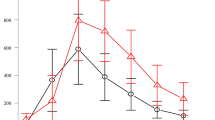Summary
The target concentration concept has been proposed as a potential alternative to the established, and probably much abused, therapeutic range method of interpreting concentrations of therapeutic drugs in plasma, serum or blood when individualising drug dosages. This paper raises for debate the possibility of extending this alternative concept to immunosuppressant monitoring with cyclosporin, where there has been considerable difficulty in establishing therapeutic ranges which are widely accepted and applied.
In its broader application, the target concentration strategy does present advantages to the clinician in precision, ability to calculate the dose directly from the target concentration and clearance, as well as a clearer concept of an optimal concentration (differentiating desired and adverse effects).
Similar content being viewed by others
References
Buchthal F, Svensmark O, Schiller PJ. Clinical and electroencephalographic correlations with serum levels of diphenylhydantoin. Arch Neurol 1960; 2: 624–30
Kutt H, Winters W, Kokenge R, et al. Diphenylhydantoin metabolism, blood levels, and toxicity. Arch Neurol 1964; 11: 642–8
Dusci LJ, Hackett P, Chiswell GM, et al. Comparison of cyclosporine in whole blood by high performance liquid chromatography, monoclonal fluorescent polarization immunoassay, and monoclonal enzyme-multiplied immunoassay. Ther Drug Monit 1992; 14: 327–32
Tsunoda SM, Aweeka FT. The use of therapeutic drug monitoring to optimise immunosuppressive therapy. Clin Pharmacokinet 1996; 30: 107–40
Shaw LM, Bowers L, Demers L, et al. Critical issues in cyclosporine monitoring: report of the task force on cyclosporine monitoring. Clin Chem 1987; 33: 1268–88
Kahan BD, Shaw LM, Holt D, et al. Consensus document: Hawk’s Cay meeting on therapeutic drug monitoring of cyclosporine. Clin Chem 1990; 36: 1510–6
Shaw LM, Yatscoff RW, Bowers LD, et al. Canadian consensus meeting on cyclosporine monitoring: report of the consensus panel. Clin Chem 1990; 36: 1841–6
Yatscoff RW. Report of the Bureau of Drug Research, Health Protection Branch and Canadian Society of Clinical Biochemists. Clin Biochem 1991; 24: 1–2
Morris RG. Australian cyclosporin therapeutic monitoring survey: 1993. Ther Drug Monit 1994; 16: 564–9
Holt DW, Johnston A, Roberts NB, et al. Methodological and clinical aspects of cyclosporin monitoring: report of the Association of Clinical Biochemists task force. Ann Clin Biochem 1994; 31: 420–46
Oellerich M, Armstrong IVW, Kahan B, et al. Lake Louise consensus conference on cyclosporin monitoring in organ transplantation: report of the consensus panel. Ther Drug Monit 1995; 17: 642–54
Morris RG, Tett SE, Ray JE. Cyclosporin A monitoring in Australia: consensus recommendations. Ther Drug Monit 1994; 16: 570–6
Jones TE, Morris RG. Survey of cyclosporin therapeutic ranges, assay methodology and use of ‘sparing agents’ in Australasian transplant centres. Ther Drug Monit. In press
Shiener LB, Tozer TN. Clinical pharmacokinetics: the use of plasma concentrations of drugs. In: Melmon KL, Morelli HF, editors. Clinical pharmacology: basic principles of therapeutics. New York: Macmillan, 1978: 71–109
Holford NHG. The target concentration approach to clinical drug development. Clin Pharmacokinet 1995; 29: 287–91
Holford N, Black P, Couch R, et al. Theophylline target concentration in severe airways obstruction: 10 or 20mg/L? Clin Pharmacokinet 1993; 25: 495–505
Morris RG, Saccoia NC, Ryall RG, et al. Specific EMIT and FPIA assays for cyclosporin compared with Cyclotrac 125IRIA. Ther Drug Monit 1992; 14: 226–33
Johnston A, Holt DW. Concentration-controlled trials. What does the future hold? Clin Pharmacokinet 1995; 28: 93–9
Author information
Authors and Affiliations
Rights and permissions
About this article
Cite this article
Morris, R.G. Target Concentration Strategy for Cyclosporin Monitoring. Clin-Pharmacokinet 32, 175–179 (1997). https://doi.org/10.2165/00003088-199732030-00001
Published:
Issue Date:
DOI: https://doi.org/10.2165/00003088-199732030-00001



